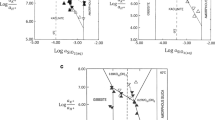Abstract
Junction probability diagrams show variation in both composition and layer arrangement in mixed-layer clay minerals. These diagrams can represent short-range and long-range ordered, random, and segregated interstratifications. Mineralogical analyses of illite/smectite from shale cuttings, bentonites, and hydrothermally altered tuffs define characteristic reaction pathways through these diagrams. Shale and bentonite analyses fall along pathways joining smectite and illite on diagrams showing nearest-neighbor (R1) layer arrangements. Transition from random to R1-ordered interstratifications occurs in shale samples containing 60–70% illite layers, and in bentonites containing 55–67% illite layers. Analyses of alteration products, however, fall near a line connecting rectorite and illite, which represents the maximum degree of Rl layer ordering. No mineralogical evidence is available to suggest that these alteration samples formed from a smectite precursor. All samples develop next-nearest (R2) and thrice-removed (R3) neighbor ordering along similar pathways. Transition to R2 ordering occurs gradually in samples composed of 65–80% illite layers, and samples containing more than 85% illite layers may show strong R3 ordering.
Similar content being viewed by others
References
Altaner, S. P. (1985) Potassium metasomatism and diffusion in Cretaceous K-bentonites from the disturbed belt, northwestern Montana and in the Middle Devonian Tioga K-bentonite, eastern U.S.A.: Ph.D. dissertation, Univ. of Illinois, Urbana, Illinois, 193 pp.
Altaner, S. P., Whitney, G., Aronson, J. L., and Hower, J. (1984) A model for K-bentonite formation, evidence from zoned K-bentonites in the disturbed belt, Montana: Geology 12, 412–415.
Boles, J. R. and Franks, S. G. (1979) Clay diagenesis in Wilcox sandstones of southwest Texas, implications of smectite diagenesis on sandstone cementation: J. Sed. Petrol. 49, 55–70.
Bradley, W. F. (1950) The alternating layer sequence of rectorite: Amer. Mineral. 35, 590–595.
Brindley, G. W. (1956) Allevardite, a swelling double-layer mica mineral: Amer. Mineral. 41, 91–103.
Brun, J. and Chagnon, A. (1979) Rock stratigraphy and clay mineralogy of volcanic ash beds from the Black River and Trenton Groups (Middle Ordovician) of southern Quebec: Canad. J. Earth Sci. 16, 1499–1507.
Hoffman, J. (1976) Regional metamorphism and K-Ar dating of clay minerals in Cretaceous sediments of the disturbed belt of Montana: Ph.D. dissertation, Case Western Reserve Univ., Cleveland, Ohio, 266 pp.
Horton, D. G. (1983) Argillic alteration associated with the Amethyst vein system, Creede Mining District: Ph.D. dissertation, Univ. of Illinois, Urbana, Illinois, 337 pp.
Hower, J., Eslinger, E. V., Hower, M., and Perry, E. A. (1976) Mechanism of burial metamorphism of argillaceous sediments, 1. Mineralogical and chemical evidence: Geol. Soc. Amer. Bull. 87, 725–737.
Hower, J. and Mowatt, T. C. (1966) The mineralogy of illites and mixed-layer illite/montmorillonites: Amer. Mineral. 51, 825–854.
Huff, W.D. and Türkmenöglü, A.G. (1981) Chemical characteristics and origin of Ordovician K-bentonites along the Cincinnati arch: Clays & Clay Minerals 29, 113–123.
MacEwan, D. M. C. (1956) Fourier transform methods for studying scattering from lamellar systems, I. A direct method for analyzing interstratified mixtures: Kolloid-Zeitschrift 149, 96–108.
MacEwan, D. M. C. (1958) Fourier transform methods for studying X-ray scattering from lamellar systems, II. The calculation of X-ray diffraction effects for various types of interstratification: Kolloid-Zeitschrift 156, 61–67.
Nadeau, P. H. and Reynolds, R.C. (1981) Burial and contact metamorphism in the Mancos shale: Clays & Clay Minerals 29, 249–259.
Perry, E. A. (1969) Burial diagenesis in Gulf Coast pelitic sediments: Ph.D. dissertation, Case Western Reserve Univ., Cleveland, Ohio, 121 pp.
Perry, E. and Hower, J. (1970) Burial diagenesis in Gulf Coast pelitic sediments: Clays & Clay Minerals 18, 165–177.
Pevear, D. R., Williams, V. E., and Mustoe, G. E. (1980) Kaolinite, smectite, and K-rectorite in bentonites, relation to coal rank at Tulameen, British Columbia: Clays & Clay Minerals 28, 241–254.
Rettke, R. C. (1976) Clay mineralogy and clay mineral distribution patterns in Dakota Group sediments, northern Denver Basin, eastern Colorado and western Nebraska: Ph.D. dissertation, Case Western Reserve Univ., Cleveland, Ohio, 135 pp.
Reynolds, R. C. (1980) Interstratified clay minerals: in Crystal Structures of Clay Minerals and their X-ray Identification, G. W. Brindley and G. Brown, eds., Mineralogical Society, London, 249–303.
Reynolds, R. C. and Hower, J. (1970) The nature of inter-layering in mixed-layer illite-montmorillonites: Clays & Clay Minerals 18, 25–36.
Roberson, H. E. and Lahann, R. W. (1981) Smectite to illite conversion rates, effects of solution chemistry: Clays & Clay Minerals 29, 129–135.
Srodon, J. (1984) X-ray powder diffraction identification of illitic materials: Clays & Clay Minerals 32, 337–349.
Vergo, N. (1984) Wallrock alteration at the Bulldog Mountain Mine, Creede Mining District, Colorado: M.S. thesis, Univ. Illinois, Urbana, Illinois, 88 pp.
Weaver, C. E. (1956) The distribution and identification of mixed-layer clays in sedimentary rocks: Amer. Mineral. 41, 202–221.
Weaver, C. E. (1959) The clay petrology of sediments: in Clays and Clay Minerals, Proc. 6th Natl. Conf, Berkeley, California, 1957, Ada Swineford, ed., Pergamon Press, New York, 154–187.
Weaver, C. E. and Beck, K. C. (1971) Clay water diagenesis during burial, how mud becomes gneiss: Geol. Soc. Amer. Special Paper 134, 96 pp.
Author information
Authors and Affiliations
Rights and permissions
About this article
Cite this article
Bethke, C.M., Vergo, N. & Altaner, S.P. Pathways of Smectite Illitization. Clays Clay Miner. 34, 125–135 (1986). https://doi.org/10.1346/CCMN.1986.0340203
Received:
Accepted:
Published:
Issue Date:
DOI: https://doi.org/10.1346/CCMN.1986.0340203




